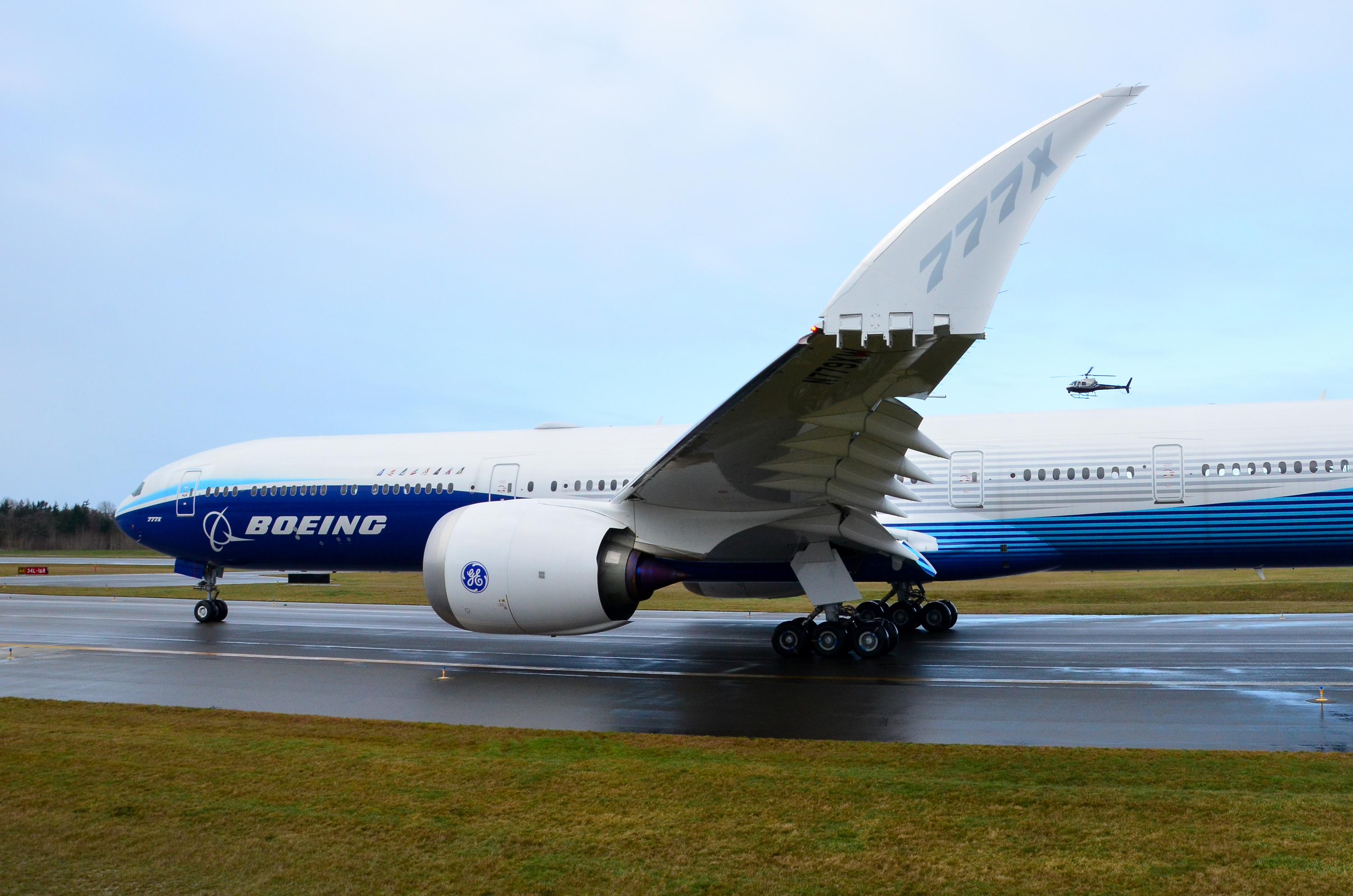This post is also available in:
![]() 简体中文 (Chinese (Simplified))
简体中文 (Chinese (Simplified))
July 2023. Kingsford Smith International Airport. Sydney, Australia. Singapore Airlines Flight 242 is on its way back home. The mid-afternoon departure rolls slowly to runway 16L. SQ242 usually uses the much-longer 16R, but a last minute change reassigned the lightly-loaded Boeing 777-9 to the shorter of Sydney’s two north-south runways for the seven-hour flight to Changi International.
The jet’s 11 and a half foot tall (3.5m) folding wing tips are still pointed straight up to the sky as it turns onto taxiway B10. The paths to runway 16L in Sydney are a mashup of tight taxiways and part of a global search by Boeing to find airports where the 777X’s transforming geometry might get hung up. The centerline of B10 is 262 feet (80 meters) from parallel taxiway L, that’s just enough for the 777X to squeeze through on its way to the runway.
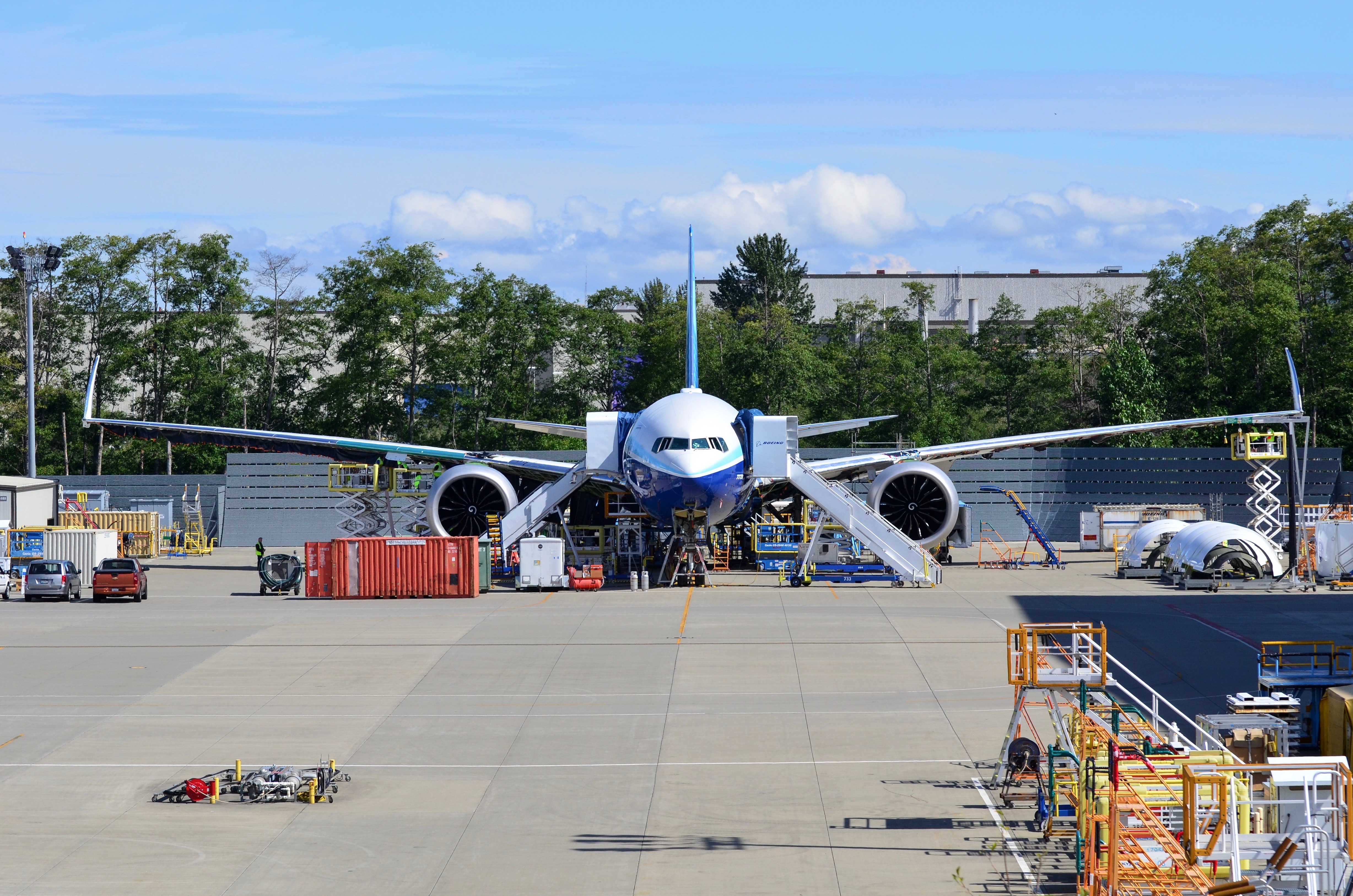
This is precisely a spot for which Boeing designed the 777X’s folding wing tip. The International Civil Aviation Organization gives this tight spot on the edge of Botany Bay a Code E taxiway classification. Just enough space for two Code E aircraft with wingspans up to 213 feet (A350 and 777) to pass one another safely. Before it left Gate 53, the crew of Singapore 242 determined during the departure briefing it would be here where the wing tips would be unfolded, ensuring they’d be down and locked before crossing the hold line on to the runway.
Related: Beyond the carrier deck: A glimpse at the 777X folding wingtip
The new folding mechanism will allow the 777X to fit onto these Code E taxiways and gates used by the smaller 777-300ER, but the aircraft is cleared to use Code F (A380 and 747-8) runways when the wing tips are unfurled to its 235-foot 5-inch (71.8 m) tip-to-tip span for takeoff and give the jet its globespanning range.
As part of its normal departure checks on B10 before entering the runway for takeoff, the crew runs through the electronic checklist. No matter the airport, in normal operation the 777X’s wing tip will be folded when not on the runway. An automatically-sensed line item added to the 777X checklist asks if the wing tips are in the folded position. Boeing matched the design of the wingfold switch to intuitively match the shape and direction of travel of the jet’s most novel feature. A quick flip from vertical (fold) to horizontal (extend) starts the process.
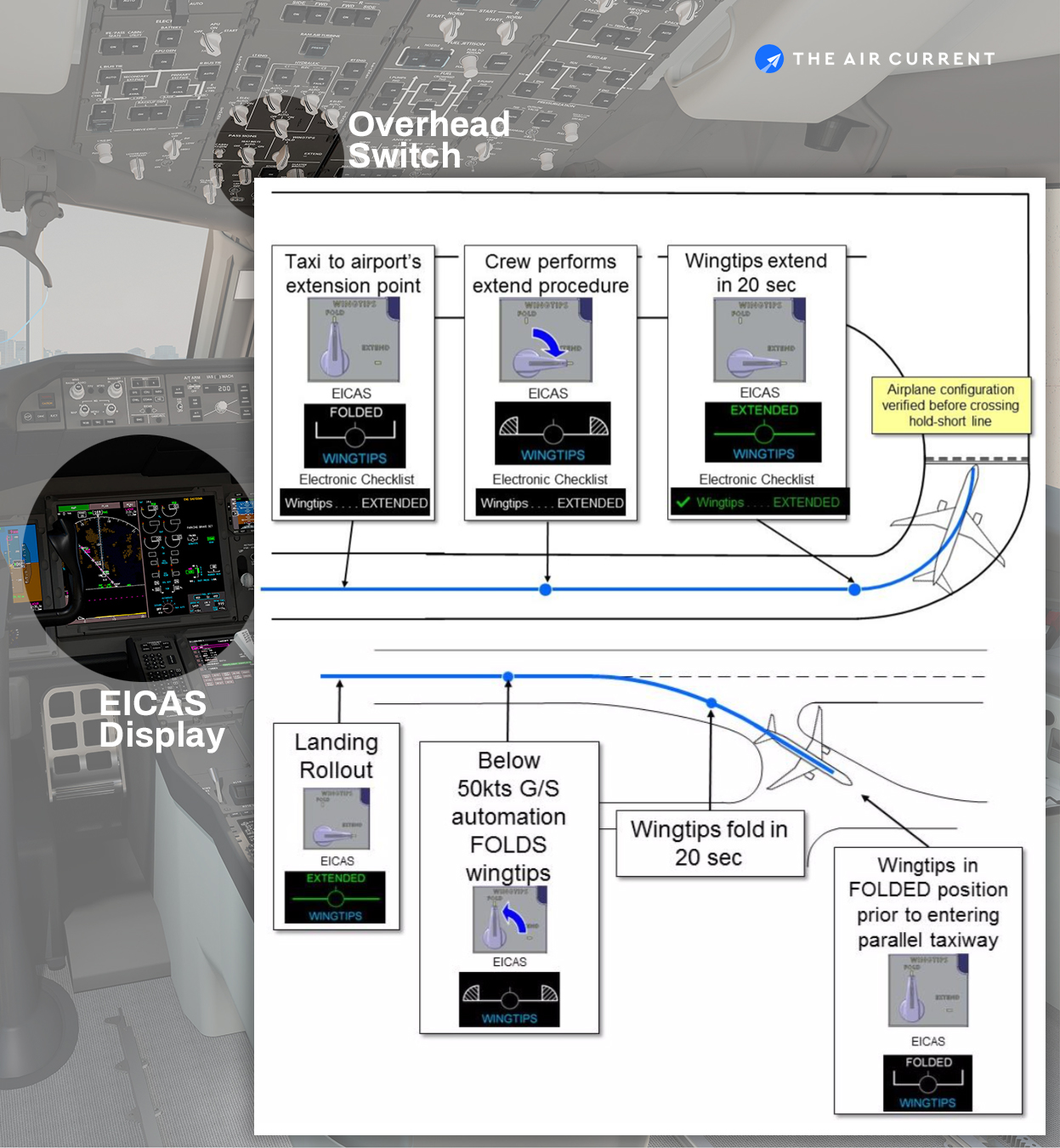
At the tip of the 777X’s carbon fiber wings, a hydraulic actuator rotates the tips to their inflight position. Once in place, electrical locking mechanisms, which only disengage when powered, hold the tips in place to fly. Boeing also added a new iconography to the Engine-indicating and crew-alerting system (EICAS) display that illustrates the tips in transit, folded and deployed positions. From start to finish the whole process takes 20 seconds.
For passengers, the shift is potentially biggest visual change out the window since propellor-driven engines were replaced by jets. Wings change shape all the time. Extending flaps and slats are all part of any normal flight, now it’s a change in direction when the wing tips disappear into the horizon.
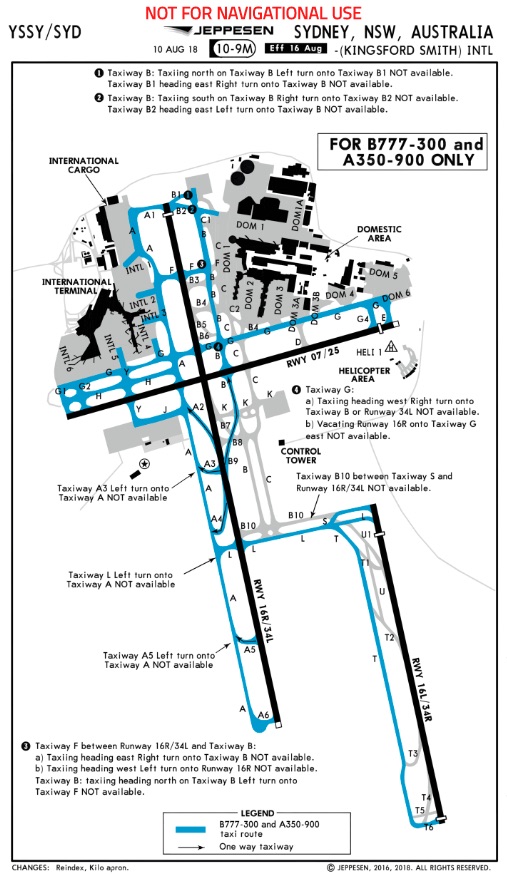 And they’ll have two ways to watch. Out the window and from a feed of the 777X’s ground maneuvering camera system piped into the seat back screen. UTC Aerospace Systems – soon to be Collins Aerospace – says the optional cameras offer “a unique passenger experience by providing a wingtip-to-wingtip view from the aircraft’s vertical stabilizer through in-flight entertainment (IFE) video.”
And they’ll have two ways to watch. Out the window and from a feed of the 777X’s ground maneuvering camera system piped into the seat back screen. UTC Aerospace Systems – soon to be Collins Aerospace – says the optional cameras offer “a unique passenger experience by providing a wingtip-to-wingtip view from the aircraft’s vertical stabilizer through in-flight entertainment (IFE) video.”
If another Code E aircraft — an A350-900, for example — had been holding on taxiway L, the 777X would be able to unfold its wings to become a Code F aircraft without restriction. In 2016, ICAO changed the rules to allow the 777X shrinking planform to slip past. The wing tip separation standard shrunk from approximately 42 feet down to 36 feet (15m to 11m) allowing the 777X to extend its wings for takeoff when another Code E aircraft is on the adjacent dual taxiway heading for a runway entrance. If SQ242 was dispatched with the folding mechanism failed, forcing the tips be locked in place, the aircraft could still access B10 without an issue.
With the jet’s wing tips unfolded and the aircraft ready to fly, Flight 242 barrels down runway 16L and heads for Singapore.
As part of its design of the 777X and its new wings, Boeing found the folding tip required 3% less block fuel compared to a wing with a blended winglet that truncated the span at Code E dimensions. The company has tried to make the system fit as seamlessly into existing operations as possible. In both the folded and unfolded positions the system can be de-iced “no differently than other wing tip devices,” according to Boeing’s guidance to airports. The enormous tips are also designed to withstand Category 1 hurricane force winds up to 82 knots – anything higher and the tips will need to be unfolded or locked in place with special ground equipment.
Seven hours and 41 minutes after leaving Sydney, SQ242’s wheels touch the pavement on runway 2L at Changi, the airline’s home base in Singapore. The 777 is slowing rapidly, its spoilers dumping lift off of its wings and GE9X’s in full reverse. The crew hasn’t had to touch the wingfold switch since it set them into position in Sydney.1 The moment the groundspeed slowed to 50 knots, the wings automatically began to fold again and the overhead switch popped to vertical.2
Boeing canvased all 400-plus operationally recorded 777-300ER airport landings to simulate if the wing tips would be safely stowed before the 777X returned to a Code E standard wingspan upon exiting the runway on a rapid-exit taxiway. “In all recorded cases,” wrote Boeing. “The aircraft would have completed wingtip folding prior to entering the taxiway.”
Back in 2018, the 777X hasn’t yet folded its wings under its own power. The tips, branded with the 777X moniker, are installed upward on the first aircraft currently undergoing final assembly in Everett, Wash. Power up of WH001, the 777X first test aircraft, is expected later this year and first flight around the end of March 2019.
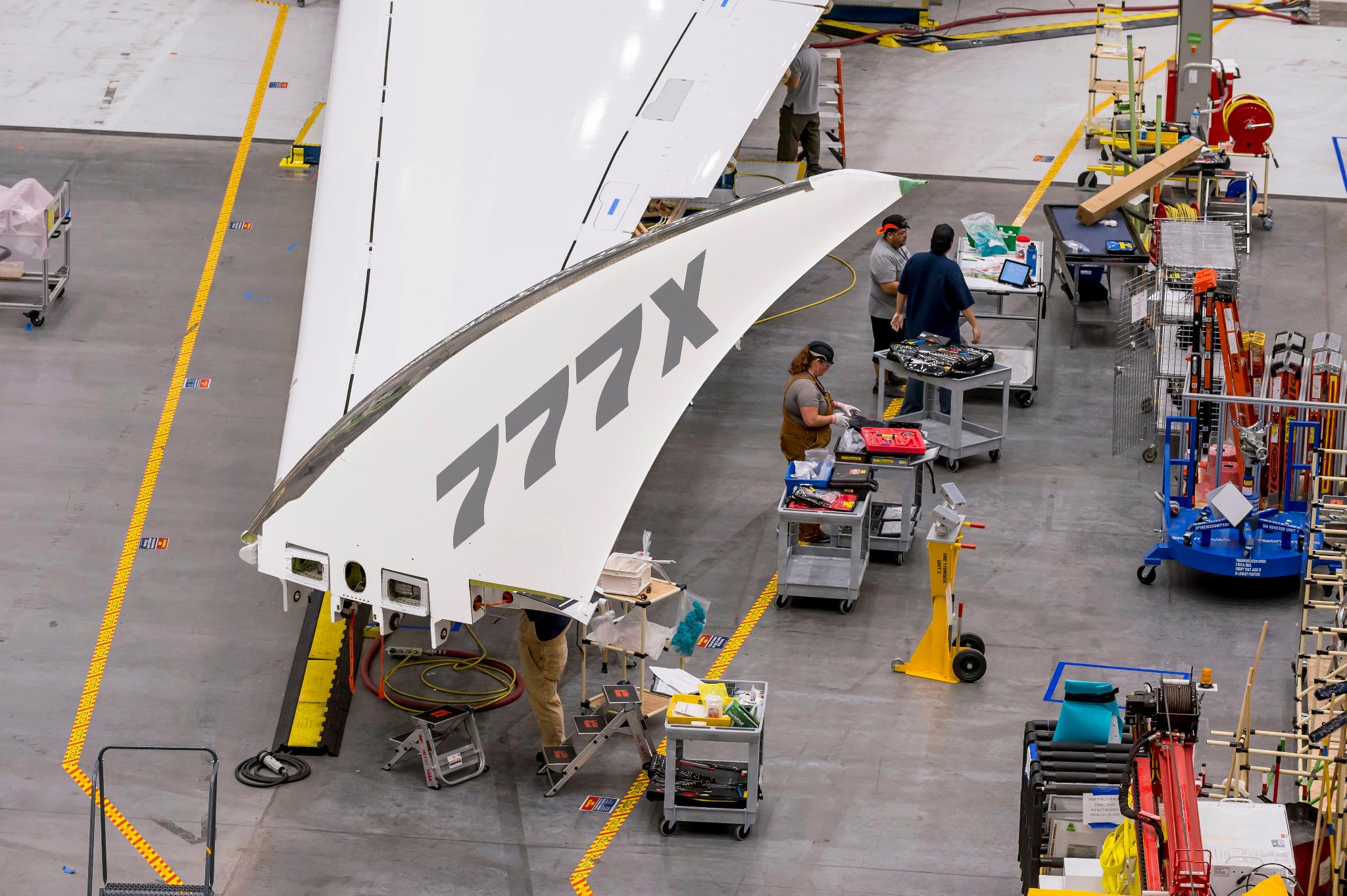
Subscribe to Continue Reading
Our award-winning aerospace reporting combines the highest standards of journalism with the level of technical detail and rigor expected by a sophisticated industry audience.
- Exclusive reporting and analysis on the strategy and technology of flying
- Full access to our archive of industry intelligence
- We respect your time; everything we publish earns your attention
